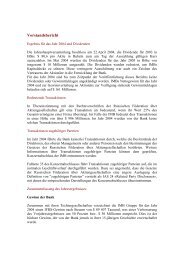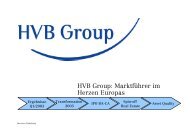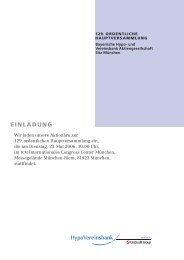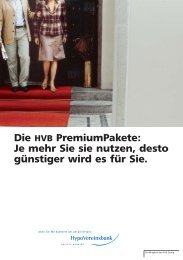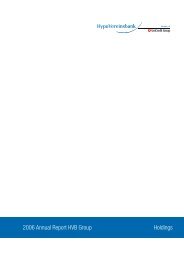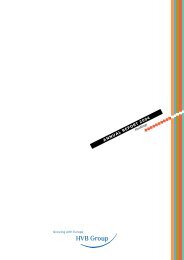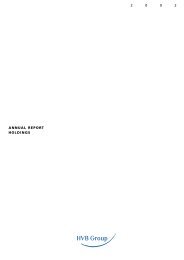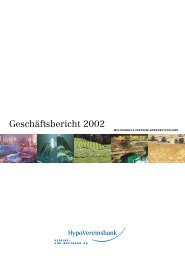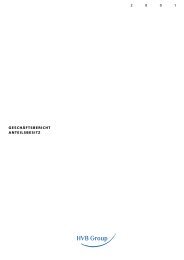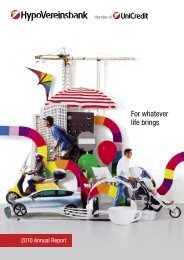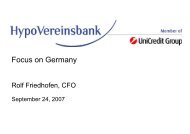Meeting real needs with concrete solutions. - Investor Relations ...
Meeting real needs with concrete solutions. - Investor Relations ...
Meeting real needs with concrete solutions. - Investor Relations ...
Create successful ePaper yourself
Turn your PDF publications into a flip-book with our unique Google optimized e-Paper software.
valuation. By contrast, the fixed-income securities, equity instruments<br />
and other assets held for trading contained <strong>with</strong>in the balance sheet<br />
item assets held for trading purposes fell by a total of €14.8 billion.<br />
Loans and receivables <strong>with</strong> customers fell by €2.8 billion, to<br />
€136.6 billion, compared <strong>with</strong> year-end 2010. This decline is attributable<br />
to lower volumes of mortgage loans, the reduction of reclassified<br />
securities, the decrease in impaired assets and lower other loans and<br />
receivables. There was a €2.1 billion decline in loans and receivables<br />
<strong>with</strong> banks to €44.3 billion as a result of the significant decline in<br />
repurchase agreements and the lower holdings of reclassified securities<br />
while bonds increased. Hedging derivatives rose year-on-year by<br />
€1.1 billion to €5.3 billion.<br />
On the liabilities side, the financial liabilities held for trading rose by<br />
€13.7 billion, to €140.8 billion, compared <strong>with</strong> year-end 2010. In the<br />
process, the negative fair values from derivative financial instruments<br />
rose as a result of market conditions by €30.0 billion in line <strong>with</strong><br />
the items on the assets side while repurchase agreements fell by<br />
€10.3 billion. In addition, debt securities decreased by €6.0 billion, to<br />
€42.7 billion, on account of issues due and deposits from customers<br />
by €1.1 billion, to €107.4 billion. Within deposits from customers,<br />
there was a decrease particularly in other liabilities due to a decline in<br />
time deposits, savings deposits and repurchase agreements (reverse<br />
repos). Deposits from banks rose by €6.0 billion, to €57.9 billion,<br />
primarily as a result of a substantial increase in volumes of reverse<br />
repos while time deposits declined. As a result of the transfer of<br />
liabilities under the sale of parts of the private banking business of<br />
UniCredit Luxembourg S.A. to DZ Privatbank S.A. at the beginning<br />
of the year, there was a decline of €0.6 billion in the balance sheet<br />
item “Liabilities of disposal groups held for sale”.<br />
At €23.3 billion, shareholders’ equity had declined by €352 million,<br />
or 1.5%, compared <strong>with</strong> year-end 2010. Alongside lower other<br />
reserves (down €96 million), this can be attributed to the profit of 2010<br />
available for distribution (€1,270 million) disbursed in the second<br />
quarter of 2011 that could not be fully offset by the consolidated<br />
profit of €1,017 million generated in the 2011 financial year.<br />
Risk-weighted assets, key capital ratios<br />
and liquidity of HVB Group<br />
The total risk-weighted assets, including market risk and operational<br />
risk, amounted to €127.4 billion at 31 December 2011 (31 December<br />
2010: €124.5 billion). The total risk-weighted assets of HVB<br />
Group increased by €2.9 billion compared <strong>with</strong> year-end 2010. This<br />
rise is attributable to the decline of €19.4 billion in risk-weighted<br />
assets for credit risk while there was an increase of €20.1 billion in<br />
risk-weighted assets for market risk and of €2.2 billion for operational<br />
risk. The risk-weighted assets for credit risks of HVB Group determined<br />
on the basis of Basel II (German Banking Act/Solvency Regulation –<br />
KWG/SolvV) by applying partial use amounted to €92.4 billion at<br />
31 December 2011 (including counterparty default risk in the trading<br />
book). At 31 December 2010, these risk-weighted assets amounted<br />
to €111.8 billion.<br />
The reduction of €19.4 billion in risk-weighted assets for credit risk<br />
is chiefly attributable to a significant decline of €6.9 billion in riskweighted<br />
assets at UniCredit Luxembourg S.A. (notably on account<br />
of changing the method applied from the standard approach to partial<br />
use) and a decline of €12.4 billion in credit risk-weighted assets in<br />
the banking book of UniCredit Bank AG.<br />
The risk-weighted asset equivalents for operational risk rose by<br />
€2.2 billion mainly in the first quarter of 2011. We refer to the<br />
description in the Risk Report (operational risk section) for an<br />
explanation of the measurement methods for operational risk.<br />
The significant increase of €20.1 billion in risk-weighted assets for<br />
market risk is predominantly due to the regulatory requirements<br />
introduced or expanded on 31 December 2011 <strong>with</strong>in the framework<br />
of the “CRD3” regarding the determination of market risk.<br />
HypoVereinsbank · 2011 Annual Report 35



